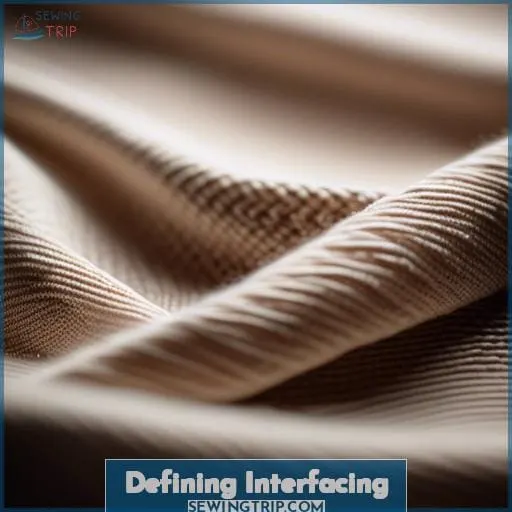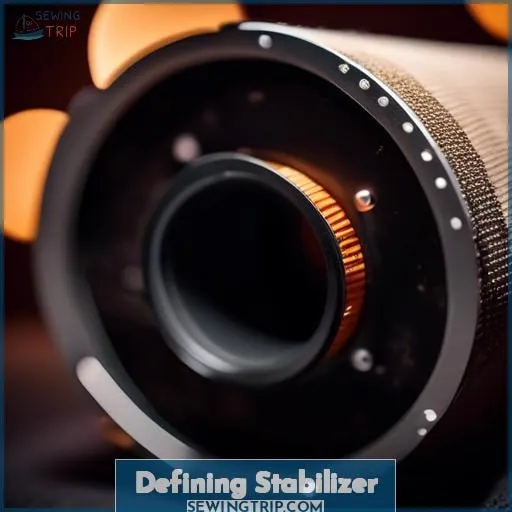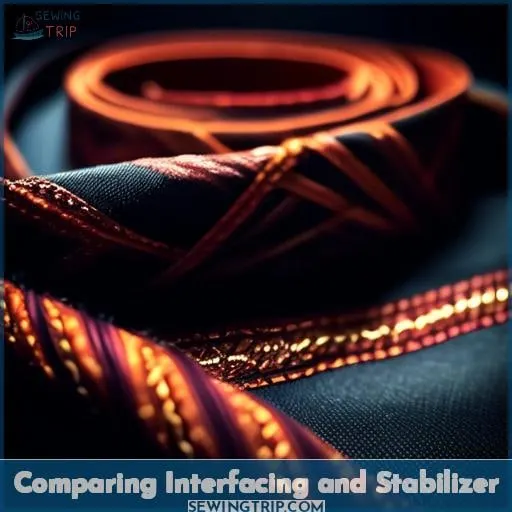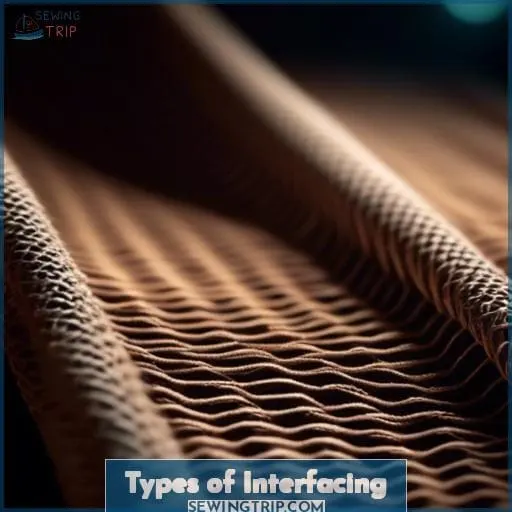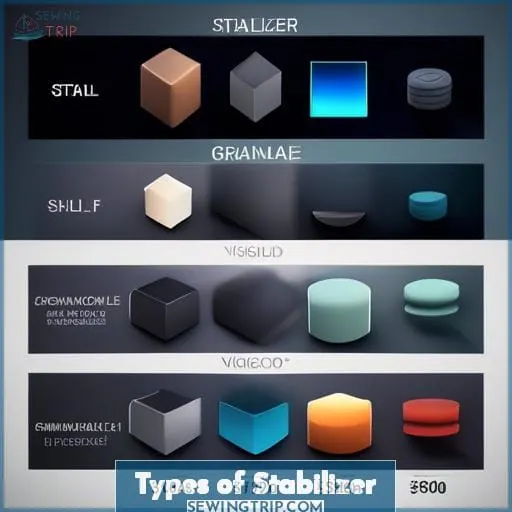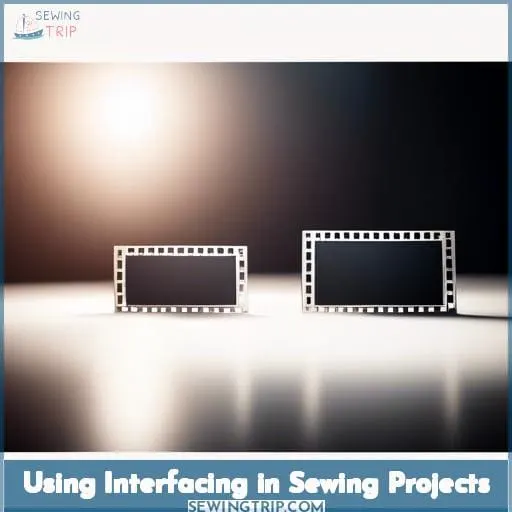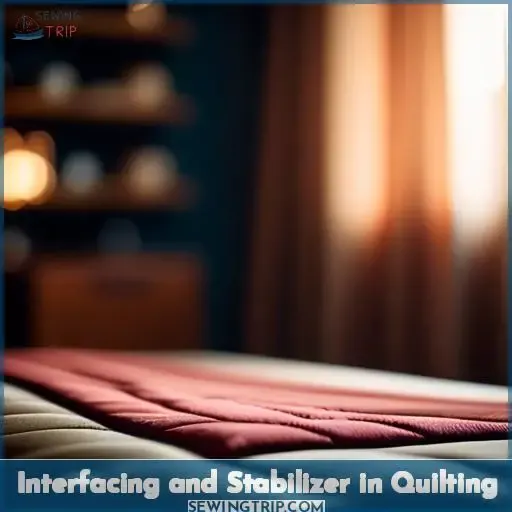This site is supported by our readers. We may earn a commission, at no cost to you, if you purchase through links.
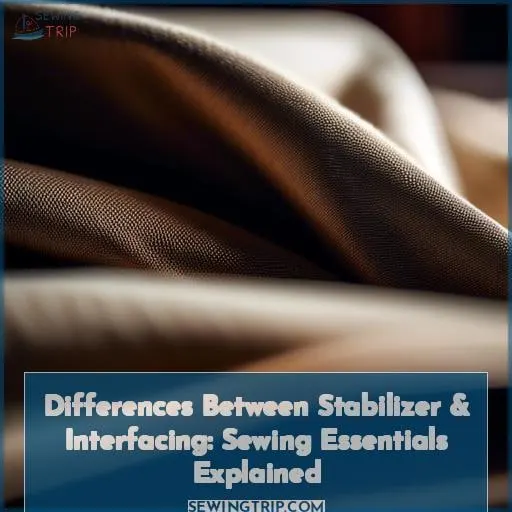
Stabilizer and interfacing, though often used interchangeably, serve distinct purposes in the crafting world. You’re about to dive into the nuances that set them apart, ensuring your projects not only look professional but also stand the test of time.
Whether you’re reinforcing a delicate fabric or ensuring your embroidery stands proud, knowing these essentials is your first step towards sewing mastery. Let’s unravel the mystery and set you on the path to informed choices in your sewing adventures.
Table Of Contents
Key Takeaways
- Interfacing is intended to be a permanent addition to fabric, providing long-term support and affecting the drape of the fabric.
- Stabilizer is designed for temporary use, offering short-term support without altering the fabric’s drape.
- Interfacing adds body and durability to garments, enhancing their appearance and structure.
- Stabilizers are used to prevent fabric puckering and support embroidery, and can be easily removed after their purpose is served.
Defining Interfacing
Interfacing is your secret weapon in sewing, acting like the skeleton within your fabric creations. It’s the unsung hero that gives your projects their shape, support, and swagger. Whether you’re crafting a crisp collar, a structured bag, or ensuring your buttonholes don’t sag, interfacing steps in to save the day.
Think of interfacing as the backbone of your fabric projects. It comes in various types, including fusible, sew-in, woven, and knit interfacing, each serving a unique purpose. Fusible interfacing, with its heat-activated adhesive, is a breeze to apply, making it a go-to for beginners and pros alike.
It’s like having a trusty sidekick that sticks with you—literally—through thick and thin fabrics. On the flip side, sew-in interfacing requires a bit more elbow grease but offers flexibility and a softer finish, perfect for those delicate or textured materials that might balk at the heat.
Woven interfacing mirrors the behavior of your fabric, moving and grooving with a natural flow, while knit interfacing stretches and bends, ideal for those stretchy, comfy garments we all love. Each type of interfacing has its place, whether you’re aiming for rigidity or flexibility, ensuring your creations not only look professional but also perform impeccably.
But interfacing isn’t just about keeping things stiff and in place. It’s about adding body, enhancing durability, and ensuring your sewing projects look as good after many wears as they did the first time you proudly wore or used them.
So, when you’re picking out interfacing, think of it as choosing the best support system for your fabric’s needs—because every great project deserves a strong foundation.
Defining Stabilizer
When you’re diving into your next sewing project, think of stabilizer as your secret sidekick, giving your fabric the backbone it needs to stand up to any challenge.
- Types of Stabilizers: You’ve got cut-away, tear-away, wash-away, and the catch-all category of specialty stabilizers. Each has its own superpower, whether it’s sticking around for the long haul or making a clean getaway after the job’s done.
- Applications of Stabilizers: These unsung heroes are perfect for keeping embroidery from going haywire, making sure your decorative stitches don’t throw a tantrum, and ensuring buttonholes and hems don’t lose their cool.
- Cost Comparison: Like shopping for the perfect pair of jeans, you’ll find stabilizers that won’t break the bank and those that might’ve you eating ramen for a week. But remember, sometimes you get what you pay for.
- Environmental Impact: If you’re eco-conscious, you’ll want to consider the footprint of your stabilizer. Wash-aways that vanish without a trace might just be your eco-friendly comrades.
Stabilizers are the unsung heroes of the sewing world, giving your projects the shape and support they need to strut their stuff. Whether you’re wrestling with a tricky fabric or aiming for that crisp, professional look, a stabilizer is your go-to partner in crime.
Comparing Interfacing and Stabilizer
Continuing from our chat about stabilizers, let’s dive into the nitty-gritty of how interfacing and stabilizers differ, shall we? Think of interfacing as the unsung hero of your apparel projects, giving collars and cuffs that crisp, professional look.
It’s like the backbone of your garment, providing support where it’s needed but bending where it must, thanks to its directional support.
Now, stabilizers, on the other hand, are the temporary scaffolding of the sewing world. They’re there to hold everything together while you work your magic with thread-heavy work like embroidery or appliqués.
Both come in sew-in or fusible options, but interfacing is in it for the long haul, becoming one with your fabric, while stabilizers are the ultimate in commitment-phobes, bowing out after their role is done.
And just like choosing a dance partner, you’ve got to pick the right type for your fabric’s rhythm—woven, non-woven, or knit for interfacing, and wash-away, tear-away, or cut-away for stabilizers.
So, when you’re beefing up a bag or giving structure to a shirt, remember: interfacing types and applications are your go-to for lasting support, while stabilizer uses and removal are all about that temporary boost.
Keep this in mind, and you’ll be sewing like a pro, with every stitch in perfect harmony with your fabric’s needs.
Types of Interfacing
When diving into the world of sewing, you’ll quickly encounter interfacing—a true shape-shifter in your fabric arsenal.
Non-woven Interfacing: This type is the jack-of-all-trades in your sewing kit. It’s like a chameleon, blending seamlessly with any fabric since it has no grain. Cut it any which way—no fraying, no fuss. It’s the go-to for a quick structure boost without the headache of matching grains.
Woven Interfacing: Think of this as the well-behaved sibling of your fabric. It plays by the rules, following the grain line just like any other fabric. It’s a bit more high-maintenance but gives that crisp, tailored look to your fine materials.
Knit Interfacing: The stretchy yoga instructor of interfacings, it moves and bends with your knit fabrics. Use it to keep your garments flexible without sacrificing their shape. It’s like a gentle hug for your stretchy materials, ensuring they don’t get out of shape.
Fusible Webbing: The double agent of the interfacing world, fusible webbing sticks two fabrics together with the stealth of a spy. It’s perfect for appliques or adding a bit of undercover support where you need it.
Types of Stabilizer
Having explored the various types of interfacing and their applications, let’s shift gears to another essential component in the world of sewing and embroidery: stabilizers. Just as a tree needs strong roots to stand tall, your sewing projects need the right type of stabilizer to maintain form and function.
So, let’s dive into the types of stabilizer and how they can be the unsung heroes of your crafting adventures.
- Cut-Away Stabilizer: This type is the Hercules of stabilizers, offering unwavering support for your fabric. It’s like a loyal friend that stays with you—permanently affixed to your project, ensuring no amount of washing or wearing can fray your masterpiece.
- Tear-Away Stabilizer: Imagine you’re performing a magic trick, and with a swift movement, the stabilizer is gone, leaving only your perfect stitches. That’s the beauty of tear-away stabilizers; they’re there when you need them and gone when you don’t.
- Wash-Away Stabilizer: Like a secret agent that vanishes without a trace, wash-away stabilizers dissolve with water, perfect for those projects where you need the stabilizer to disappear completely, leaving no evidence behind.
- Heat-Away Stabilizer: When heat is applied, this stabilizer type bids adieu, ideal for those delicate projects where other removal methods might be too abrasive.
Whether you’re reinforcing a tote bag with a cut-away stabilizer or adding intricate embroidery to a sheer fabric with a wash-away option, stabilizers are your silent partners in crafting. They may not always take the spotlight, but their role is crucial in ensuring your creations stand the test of time and use.
Using Interfacing in Sewing Projects
Transitioning from the various types of stabilizers, let’s dive into the world of interfacing in your sewing projects. Think of interfacing as the unsung hero that gives your garments the poise and structure they deserve.
Whether you’re reinforcing a snappy collar or ensuring your t-shirt doesn’t stretch out of shape, interfacing is your go-to ally.
Here’s a quick cheat sheet to keep you on track:
| Interfacing Type | Best for | Why Use It? |
|---|---|---|
| Lightweight | T-shirts | Prevents stretching |
| Medium-weight | Tote bags | Adds body and durability |
| Heavyweight | Coats | Provides robust structure |
Using Stabilizer for Embroidery
When diving into the world of machine embroidery, you’ll quickly find that stabilizers are your secret weapon for impeccable designs. Think of stabilizers as the unsung heroes that keep your fabric from turning into a puckered mess.
- Choose the Right Type: Match the stabilizer to your fabric and embroidery type. For delicate applique work, a water-soluble stabilizer works wonders, while tear-away options are perfect for projects where you want no trace of the stabilizer after completion.
- Consider the Weight: Just like choosing a bowling ball, the weight of your stabilizer matters. Go for a heavier option when your design is stitch-heavy, and use a lighter touch for simpler patterns.
- Apply with Care: If you’re using fusible fleece or a fusible stabilizer, make sure to apply heat evenly and let it cool before you start your machine embroidery. This ensures everything stays in place without any unwanted wrinkles.
- Remove Properly: After you’ve finished your masterpiece, remove the stabilizer according to its type. Wash away the water-soluble kind, gently tear away the tear-away, and cut away any excess from the cut-away stabilizers.
Interfacing and Stabilizer in Quilting
Moving from the intricate dance of embroidery, where stabilizers play the lead role, let’s waltz over to the cozy world of quilting. Here, both interfacing and stabilizer find their rhythm in a different tune. Quilting, that timeless craft of stitching layers together, often calls for interfacing to add body and form to our fabric masterpieces.
Whether you’re using fusible interfacing to effortlessly bond layers with the heat of an iron, or opting for non-fusible interfacing that requires a more traditional sew-in approach, the goal is the same: to achieve that perfect quilted look that stands the test of time.
Interfacing in quilting isn’t just about structure; it’s about crafting a legacy that drapes just right and endures cuddle after cuddle. And let’s not forget the types of stabilizer in quilting—tear-away, wash-away, and cut-away—each with its own special role in ensuring every stitch is a stitch of quality.
So, whether you’re piecing together a patchwork of memories or quilting a vision of the future, remember that interfacing and stabilizer are your silent partners, ensuring every piece is perfectly poised and every quilt is a hug waiting to happen.
Frequently Asked Questions (FAQs)
Can interfacing be used to stabilize knits?
Yes, you can use interfacing to stabilize knits. Just ensure you pick the right type, like a knit-specific fusible interfacing, to maintain some stretch.
Is stabilizer suitable for sheer fabrics?
Yes, stabilizer is indeed suitable for sheer fabrics. It prevents puckering and distortion, making it easier to sew on these tricky materials.
You’ll find both fusible and wash-away options perfect for the job.
Does interfacing affect fabric breathability?
Yes, interfacing can affect fabric breathability, especially if it’s fusible and applied in multiple layers.
Lighter, woven interfacing allows more air flow compared to heavier, non-woven types.
Choose wisely to keep your creations comfortable and breathable.
Can stabilizer be reused after removal?
Yes, stabilizer can often be reused after removal.
Crafty sewers save larger pieces, stitching them back together or using heat to fuse water-soluble types for another go-round.
It’s a savvy move to stretch your supplies and save some cash.
How does interfacing impact fabric drape?
You might think interfacing is just another layer, but it’s a game-changer for fabric drape. It adds body and support, subtly shaping your garment without compromising its flow.
Think of it as your fabric’s invisible backbone, ensuring elegance and structure in every move.
Conclusion
Just as a compass guides a sailor through the open seas, understanding the differences between stabilizer and interfacing steers you towards sewing success.
You’re now equipped with the knowledge to choose the right support for your fabric, whether it’s the structure of interfacing for garments or the foundation of stabilizer for embroidery.

